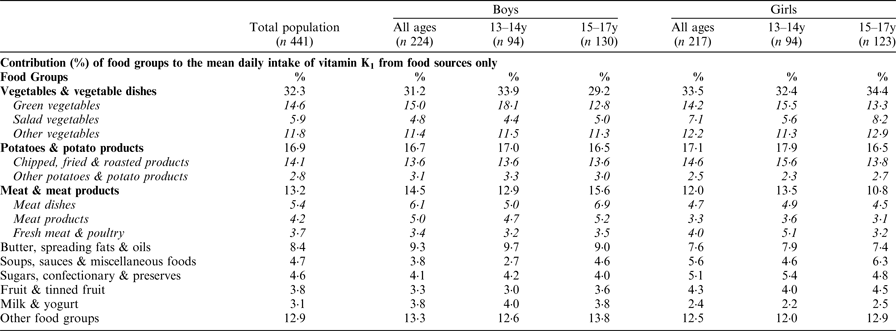Recent evidence suggests a role of vitamin K beyond its traditional role in blood coagulation(Reference Booth1). An improved vitamin K status has been associated with an increase in childhood bone mineral content over time(Reference Van Summeren, Van Coeverden and Schurgers2). The European Food Safety Authority (EFSA) has found insufficient evidence to set an Estimated Average Requirement (EAR) for vitamin K but has set an Adequate Intake (AI) of 1·0μg/kg bodyweight per day for all age and gender populations for vitamin K1 only based on observed intakes in healthy populations(3). The objective of this analysis was to estimate the intake and sources of vitamin K1 in Irish teenagers aged 13–17 years using data collected from the National Teens’ Food Survey (NTFS) (www.iuna.net). A 7-day semi-weighed food record was used to estimate dietary intakes for 441 teenagers. The vitamin K1 content of foods was primarily determined using data from the UK food composition tables (COFID)(4). For certain foods where vitamin K1 values were not available in COFID(4), data from the US food composition tables(5) and published papers were used to assign suitable values. The vitamin K1 contents of composite dishes and retail products were calculated based on their ingredients. Body weight (kg) was measured in the participants’ homes by trained researchers. Usual intakes of vitamin K1 were calculated via the NCI-method(Reference Tooze, Kipnis and Buckman6) using SAS Enterprise Guide. Differences in vitamin K1 intakes were assessed using a Kruskal-Wallis test (non-normal data) and a Wilcoxon two sample test for post-hoc analysis.

The mean daily intake (MDI) of vitamin K1 was 55 μg/d in the total population (boys; 60 μg/d, girls; 50 μg/d). Adjusted for bodyweight, the MDI was 1 ·0 μg/kg/d for boys aged 13–14 years and 0·9 μg/kg/d for boys aged 15–17 years and girls (all ages). Boys aged 13–14 years had significantly higher intakes (μg/kg/d) (p < 0·001) than all other age and gender groups. ‘Vegetable and vegetable dishes’ was the highest contributor to vitamin K1 intakes in the total population at 32%, of which 15% came from ‘green vegetables’. ‘Potatoes & potato products’, ‘meat and meat products’ and ‘butter, spreading fats & oils’ contributed 17, 13 and 8% of the MDI of vitamin K1 in the total population, respectively. Vitamin K1 intakes in Irish teenagers may be considered less than optimal as intakes are below observed AIs for each age/gender group examined with the exception of younger teenage boys. Further research is required to investigate the implications of lower vitamin K intakes in overall health.
This research was funded by the Department of Agriculture, Food and the Marine under the project ‘Development of biofortification approaches for enhanced vitamin K content of foods (15/F/670)’


